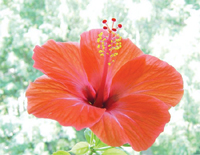|

âEmbarkâing on its second chapter
NEUTERING PROGRAMME: The second project of Otara Gunewardenaâs
Personal Corporate Social Responsibility (CSR) initiative - Embark - was
launched in aid of stray and community dogs from June 28.
This second project, partly funded by Hatton National Bank, will seek
out 300 community dogs as part of its Catch, Neuter, Vaccinate and
Release (CNVR) programme over a period of 12 to 14 days and will target
stray and community dogs within a radius of five kilometres around the
Colombo General Hospital.
Flower of the week:
Enchanting Hibiscus
There are two varieties of hibiscus: Tropical hibiscus and Hardy
hibiscus.
 If your hibiscus has glossy deep green leaves, 3-6â flowers of red,
pink, orange, yellow, double or single flowers, it is probably a
Tropical hibiscus. If your hibiscus has glossy deep green leaves, 3-6â flowers of red,
pink, orange, yellow, double or single flowers, it is probably a
Tropical hibiscus.
While many common garden varieties have the 3-6â blooms, many of the
hybrid varieties of tropical hibiscus can have blooms around 10â in
diameter under ideal conditions.
Another way to check is if the flowers are salmon, peach, orange, or
yellow, or double flowered, then you probably have a Tropical hibiscus.
Hardy hibiscus does not come in these colours or in doubles! Many
tropical hibiscus flowers have more than one colour in a bloom either in
bands or as spots.
They detest cold, rainy weather and cold, wet soil. Make sure that
the soil drains well. Hibiscus can be grown from stems and it is best to
grow them on a sunny spot.
Treating your tropical hibiscus correctly will give you years of
enjoyment. But remember, they are not immortal!
Tips and tricks on keeping pests out of your
houseplants,
Daveâs Garden contributor
 If you have indoor plants that you want to keep as pest-free as
possible, but you donât want to use a lot of chemicals, then think not
only about killing the pests, but also about never letting them in - or
at least reducing the influx as much as possible without stressing out
totally. Letâs face it... We donât grow in a vacuum and we like to get
new plants. If you have indoor plants that you want to keep as pest-free as
possible, but you donât want to use a lot of chemicals, then think not
only about killing the pests, but also about never letting them in - or
at least reducing the influx as much as possible without stressing out
totally. Letâs face it... We donât grow in a vacuum and we like to get
new plants.
The more plants we get, the higher the risk of getting new pests and
viruses. And the more plants we have, and the smaller/more cramped our
growing/propagating space, the higher the risk that a pest outbreak can
take out our entire collection.
Itâs difficult to discuss pest control generally when we live in
different climates and grow on different scales.
Obviously, if you live in a place where itâs not unusual to have a
hedge infested with mealybugs, then mealy control is going to be
difficult. If you want to move plants in and out of the home and not use
the âbig gunâ chemicals, then of course youâre more prone to all kinds
of pests.
Mites, in particular are really difficult to deal with, especially
the ones that donât make webs, are not a bright orange, or are otherwise
pretty much invisible. Some people, especially folks who live where
mealies are all over the yard, may disagree, but dealing with mealies
and scales is childâs play in comparison to mites.
Part of the mite problem is that the infestation isnât visible until
you really have a problem. Several years may pass after the first ones
walk into your home before you actually notice a problem.
Another big part of the problem is that insecticides generally do not
work on mites - mites are arachnids and so a roach killer is more likely
to kill mites. (I said âmore likelyâ not just to be clear.) The
insecticides may be killing off the natural predators of the mites.
Not even all miticides actually kill off a population; some just
suppress it. Not all miticides kill the eggs. Mites develop immunity to
miticides.
âSystemicâ doesnât always mean systemic. And you can pretty much bet
that whatever great miticide you have, there are some mites that wonât
die. Ever look at miticides? Wonder why theyâre so expensive? Mites are
a tough problem to crack.
If you have an indoor grow area that you want to keep as pest-free as
possible, but you donât want to use a lot of chemicals, then think not
only about killing the pests, but also about never letting them in - or
at least reducing the influx as much as possible without stressing out
totally.
This is where we should stop for a moment and think about what we buy
and how we bring plants in. When I say âwhat you buy and how you buyâ,
Iâm not talking about whether the source (grower and distributor) are
reputable or reliable, or if they spray pesticides a lot, etc., although
all of these are things you probably want to consider.
What I want to point out is that itâs easier to debug seeds and
rhizomes than leaves, and a couple of leaves are easier than a plant.
(Sorry, African Violet chimera fans... this is not very helpful for
you.)
Obviously, if you want a particular cultivar, you have to get some
plant material. But if you want a species, then could you grow it from
seed? One of the reasons I keep recommending that people try growing
from seed is that seeds are relatively risk free. (And yes, hybridizing
is fun, and perpetuating species is good, and growing weird species is
also all good.)
If you want a cultivar, get the plant piece with the least risk. For
example, if you are considering getting a Kohleria, do you really need a
pot of leaves? Why not just get rhizomes? They are fairly tough to kill,
and they sprout and grow quite quickly. Although a cutting might give
you flowers faster, a rhizome is one step ahead in maturity anyway.
Selecting what plant piece you get is an easy way to reduce the
probability that youâll bring in pests.
But of course, we canât get away with never bringing in foliage. So
what do you do when you bring in new cuttings or new plants? Remember,
itâs safe to assume you canât see pests and eggs, and that they are
airborne. They can hitch a ride on pots, bags, clothing, hair, hands,
nails, and air.....
Letâs assume that you have a spot for isolating new plants. Is this
just a separate shelf or room? That may not be enough. Is it a vented
humidity dome? That may also not be enough - there are holes in it,
after all.
It is a sealed container? Not to sound totally pessimistic, but that
may also not be enough - after all, you have to open it to water the
plants and exchange the air (even if that is once every 2 months like at
my place), and when you open the lid - whoosh - a lot of air movement.
Itâs still possible to reduce your risk. Pause a moment to think
about how you get the plant from your car/porch to the isolation area.
Each additional step you build in to your plant-welcoming routine helps
a little bit to reduce your risk. Take enough steps and youâre
significantly closer to pest control.
Consider the following....
If you just visited a greenhouse:
Could you possibly have brought bugs or eggs with you on your hair or
clothes? I first considered this when I was at an orchid greenhouse with
epiphytic cacti hanging from above and there were clumps of mealies on
the cacti. I went straight to the shower when I got home.
Did you touch plants while you were there? Should you be washing your
hands and cleaning under your nails? Okay, this sounds anal, but you
know we should always wash our hands.
As for plants:
Are they covered - like in a plastic bag - when you walk into the
house? This would be good practice.
Did you carry an uncovered plant through the living room and past the
plant shelves before taking it to the bathroom/kitchen/de-bugging bench?
Do you sterilize your new potting mix? Anyone who has bought a bag of
soil only to find it miraculously gave birth to fungus gnats knows that
you should never trust those bags. Dried compressed mix is fairly safe
though.
Are you cleaning your tools between each plant, pot and soil? Blades
should also be sterilized against virus.
What about your hands? Did you just pick up a new plant, dump the
soil, and then pick up a clean pot? Or did you just handle a new plant,
and then walk over to mix up a batch of potting mix?
Do you wear gloves while re-potting? Are they disposable or are you
using gardening gloves?
Do you give your new leaves and cuttings a dip in a treatment bath?
Wash them down to physically remove anything that will come off?
When you water, does the tip of your watering can or water bottle
touch the plants at all? Are you inadvertently spreading the love?
Itâs about balancing precautions and the joy of growing. Itâs about
stopping to think about your routine to see if changing a few things
might decrease the risk of bringing in an infestation. It makes no sense
to continue habits that could contribute to increasing your pest risk
level, when you could just as easily have other habits that decrease
your pest risk level.
Always get the least risky plant part.
Get rid of the bug-prone parts as far away from my grow area as
possible. If I get a new plant with foliage, this includes removing dead
plant material, de-potting if I know Iâm going to do that, removing soil
or potting medium that might have larvae, eggs, bush snails, etc.,
spraying or dipping in a pesticide. |

